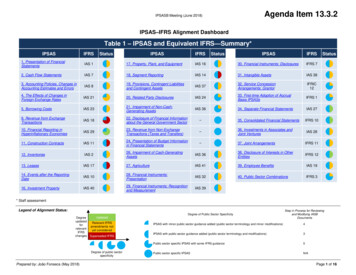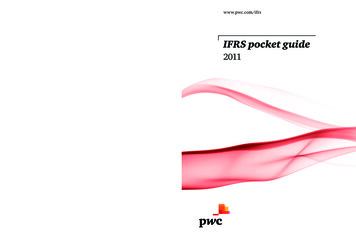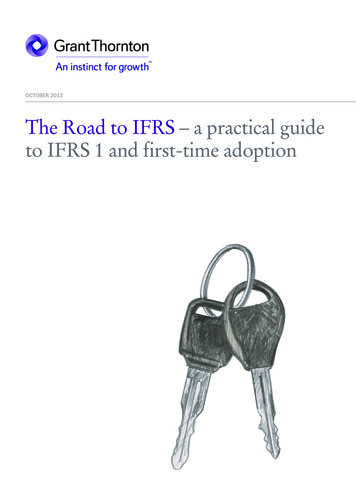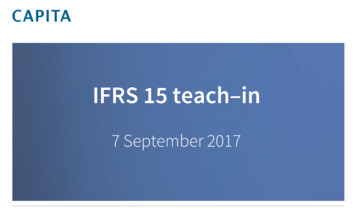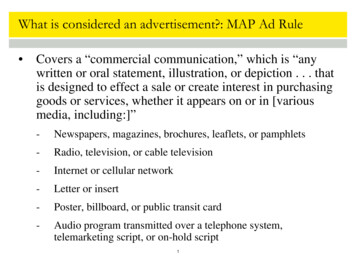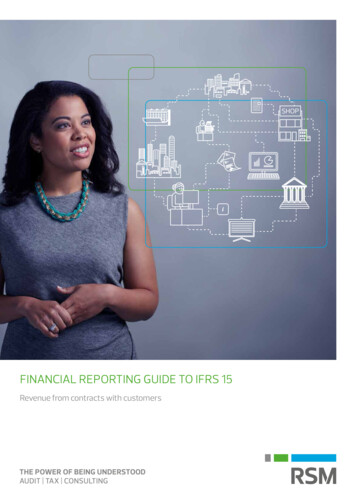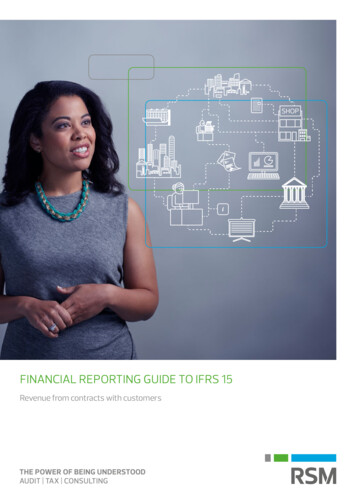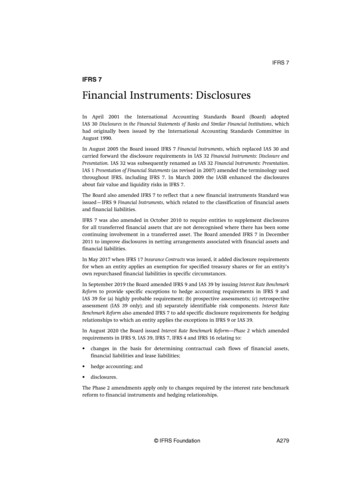
Transcription
IFRS 7IFRS 7Financial Instruments: DisclosuresIn April 2001 the International Accounting Standards Board (Board) adoptedIAS 30 Disclosures in the Financial Statements of Banks and Similar Financial Institutions, whichhad originally been issued by the International Accounting Standards Committee inAugust 1990.In August 2005 the Board issued IFRS 7 Financial Instruments, which replaced IAS 30 andcarried forward the disclosure requirements in IAS 32 Financial Instruments: Disclosure andPresentation. IAS 32 was subsequently renamed as IAS 32 Financial Instruments: Presentation.IAS 1 Presentation of Financial Statements (as revised in 2007) amended the terminology usedthroughout IFRS, including IFRS 7. In March 2009 the IASB enhanced the disclosuresabout fair value and liquidity risks in IFRS 7.The Board also amended IFRS 7 to reflect that a new financial instruments Standard wasissued—IFRS 9 Financial Instruments, which related to the classification of financial assetsand financial liabilities.IFRS 7 was also amended in October 2010 to require entities to supplement disclosuresfor all transferred financial assets that are not derecognised where there has been somecontinuing involvement in a transferred asset. The Board amended IFRS 7 in December2011 to improve disclosures in netting arrangements associated with financial assets andfinancial liabilities.In May 2017 when IFRS 17 Insurance Contracts was issued, it added disclosure requirementsfor when an entity applies an exemption for specified treasury shares or for an entity’sown repurchased financial liabilities in specific circumstances.In September 2019 the Board amended IFRS 9 and IAS 39 by issuing Interest Rate BenchmarkReform to provide specific exceptions to hedge accounting requirements in IFRS 9 andIAS 39 for (a) highly probable requirement; (b) prospective assessments; (c) retrospectiveassessment (IAS 39 only); and (d) separately identifiable risk components. Interest RateBenchmark Reform also amended IFRS 7 to add specific disclosure requirements for hedgingrelationships to which an entity applies the exceptions in IFRS 9 or IAS 39.In August 2020 the Board issued Interest Rate Benchmark Reform―Phase 2 which amendedrequirements in IFRS 9, IAS 39, IFRS 7, IFRS 4 and IFRS 16 relating to: changes in the basis for determining contractual cash flows of financial assets,financial liabilities and lease liabilities; hedge accounting; and disclosures.The Phase 2 amendments apply only to changes required by the interest rate benchmarkreform to financial instruments and hedging relationships. IFRS FoundationA279
IFRS 7Other Standards have made minor amendments to IFRS 7. They include Limited Exemptionfrom Comparative IFRS 7 Disclosures for First-time Adopters (Amendments to IFRS 1) (issuedJanuary 2010), Improvements to IFRSs (issued May 2010), IFRS 10 Consolidated FinancialStatements (issued May 2011), IFRS 11 Joint Arrangements (issued May 2011), IFRS 13 FairValue Measurement (issued May 2011), Presentation of Items of Other ComprehensiveIncome (Amendments to IAS 1) (issued June 2011), Mandatory Effective Date and TransitionDisclosures (Amendments to IFRS 9 (2009), IFRS 9 (2010) and IFRS 7) (issued December2011), Investment Entities (Amendments to IFRS 10, IFRS 12 and IAS 27) (issued October2012), IFRS 9 Financial Instruments (Hedge Accounting and amendments to IFRS 9, IFRS 7and IAS 39) (issued November 2013), Annual Improvements to IFRSs 2012–2014 Cycle (issuedSeptember 2014), Disclosure Initiative (Amendments to IAS 1) (issued December 2014),IFRS 16 Leases (issued January 2016), Annual Improvements to IFRS Standards 2014–2016Cycle (issued December 2016) and Amendments to IFRS 17 (issued June 2020).A280 IFRS Foundation
IFRS 7CONTENTSfrom paragraphINTERNATIONAL FINANCIAL REPORTING STANDARD 7FINANCIAL INSTRUMENTS: DISCLOSURESOBJECTIVE1SCOPE3CLASSES OF FINANCIAL INSTRUMENTS AND LEVEL OF DISCLOSURE6SIGNIFICANCE OF FINANCIAL INSTRUMENTS FOR FINANCIAL POSITIONAND PERFORMANCE7Statement of financial position8Statement of comprehensive income20Other disclosures21NATURE AND EXTENT OF RISKS ARISING FROM FINANCIALINSTRUMENTS31Qualitative disclosures33Quantitative disclosures34TRANSFERS OF FINANCIAL ASSETS42ATransferred financial assets that are not derecognised in their entirety42DTransferred financial assets that are derecognised in their entirety42ESupplementary information42HINITIAL APPLICATION OF IFRS 942IEFFECTIVE DATE AND TRANSITION43WITHDRAWAL OF IAS 3045APPENDICESA Defined termsB Application guidanceC Amendments to other IFRSsAPPROVAL BY THE BOARD OF IFRS 7 ISSUED IN AUGUST 2005APPROVAL BY THE BOARD OF AMENDMENTS TO IFRS 7:Improving Disclosures about Financial Instruments issued in March 2009Disclosures—Transfers of Financial Assets issued in October 2010Mandatory Effective Date of IFRS 9 and TransitionDisclosures (Amendments to IFRS 9 (2009), IFRS 9 (2010) and IFRS 7)issued in December 2011Disclosures—Offsetting Financial Assets and FinancialLiabilities (Amendments to IFRS 7) issued in December 2011IFRS 9 Financial Instruments (Hedge Accounting and amendments toIFRS 9, IFRS 7 and IAS 39) issued in November 2013Interest Rate Benchmark Reform issued in September 2019Interest Rate Benchmark Reform—Phase 2 issued in August 2020continued. IFRS FoundationA281
IFRS 7.continuedFOR THE ACCOMPANYING GUIDANCE LISTED BELOW, SEE PART B OF THIS EDITIONIMPLEMENTATION GUIDANCEAPPENDIXAmendments to guidance on other IFRSsFOR THE BASIS FOR CONCLUSIONS, SEE PART C OF THIS EDITIONBASIS FOR CONCLUSIONSAPPENDIX TO THE BASIS FOR CONCLUSIONSAmendments to Basis for Conclusions on other IFRSsA282 IFRS Foundation
IFRS 7International Financial Reporting Standard 7 Financial Instruments: Disclosures (IFRS 7) isset out in paragraphs 1–45 and Appendices A–C. All the paragraphs have equalauthority. Paragraphs in bold type state the main principles. Terms definedin Appendix A are in italics the first time they appear in the Standard. Definitions ofother terms are given in the Glossary for International Financial Reporting Standards.IFRS 7 should be read in the context of its objective and the Basis for Conclusions,the Preface to IFRS Standards and the Conceptual Framework for FinancialReporting. IAS 8 Accounting Policies, Changes in Accounting Estimates and Errors provides abasis for selecting and applying accounting policies in the absence of explicit guidance. IFRS FoundationA283
IFRS 7International Financial Reporting Standard 7Financial Instruments: DisclosuresObjective12The objective of this IFRS is to require entities to provide disclosures in theirfinancial statements that enable users to evaluate:(a)the significance of financial instruments for the entity’s financialposition and performance; and(b)the nature and extent of risks arising from financial instruments towhich the entity is exposed during the period and at the end of thereporting period, and how the entity manages those risks.The principles in this IFRS complement the principles for recognising,measuring and presenting financial assets and financial liabilities in IAS 32Financial Instruments: Presentation and IFRS 9 Financial Instruments.Scope3A284This IFRS shall be applied by all entities to all types of financial instruments,except:(a)those interests in subsidiaries, associates or joint ventures that areaccounted for in accordance with IFRS 10 Consolidated FinancialStatements, IAS 27 Separate Financial Statements or IAS 28 Investments inAssociates and Joint Ventures. However, in some cases, IFRS 10, IAS 27 orIAS 28 require or permit an entity to account for an interest in asubsidiary, associate or joint venture using IFRS 9; in those cases,entities shall apply the requirements of this IFRS and, for thosemeasured at fair value, the requirements of IFRS 13 Fair ValueMeasurement. Entities shall also apply this IFRS to all derivatives linkedto interests in subsidiaries, associates or joint ventures unless thederivative meets the definition of an equity instrument in IAS 32.(b)employers’ rights and obligations arising from employee benefit plans,to which IAS 19 Employee Benefits inIFRS17InsuranceContracts or investment contracts with discretionary participationfeatures within the scope of IFRS 17. However, this IFRS applies to:(i)derivatives that are embedded in contracts within the scope ofIFRS 17, if IFRS 9 requires the entity to account for themseparately.(ii)investment components that are separated from contractswithin the scope of IFRS 17, if IFRS 17 requires such separation,unless the separated investment component is an investmentcontract with discretionary participation features. IFRS Foundation
IFRS 7(iii)an issuer’s rights and obligations arising under insurancecontracts that meet the definition of financial guarantee contracts,if the issuer applies IFRS 9 in recognising and measuring thecontracts. However, the issuer shall apply IFRS 17 if the issuerelects, in accordance with paragraph 7(e) of IFRS 17, to applyIFRS 17 in recognising and measuring the contracts.(iv)an entity’s rights and obligations that are financial instrumentsarising under credit card contracts, or similar contracts thatprovide credit or payment arrangements, that an entity issuesthat meet the definition of an insurance contract if the entityapplies IFRS 9 to those rights and obligations in accordancewith paragraph 7(h) of IFRS 17 and paragraph 2.1(e)(iv) ofIFRS 9.(v)an entity’s rights and obligations that are financial instrumentsarising under insurance contracts that an entity issues thatlimit the compensation for insured events to the amountotherwise required to settle the policyholder’s obligationcreated by the contract, if the entity elects, in accordance withparagraph 8A of IFRS 17, to apply IFRS 9 instead of IFRS 17 tosuch contracts.(e)financial instruments, contracts and obligations under share-basedpayment transactions to which IFRS 2 Share-based Payment applies,except that this IFRS applies to contracts within the scope of IFRS 9.(f)instruments that are required to be classified as equity instruments inaccordance with paragraphs 16A and 16B or paragraphs 16C and 16Dof IAS 32.4This IFRS applies to recognised and unrecognised financial instruments.Recognised financial instruments include financial assets and financialliabilities that are within the scope of IFRS 9. Unrecognised financialinstruments include some financial instruments that, although outside thescope of IFRS 9, are within the scope of this IFRS.5This IFRS applies to contracts to buy or sell a non-financial item that arewithin the scope of IFRS 9.5AThe credit risk disclosure requirements in paragraphs 35A–35N apply to thoserights that IFRS 15 Revenue from Contracts with Customers specifies are accountedfor in accordance with IFRS 9 for the purposes of recognising impairmentgains or losses. Any reference to financial assets or financial instruments inthese paragraphs shall include those rights unless otherwise specified.Classes of financial instruments and level of disclosure6When this IFRS requires disclosures by class of financial instrument, an entityshall group financial instruments into classes that are appropriate to thenature of the information disclosed and that take into account thecharacteristics of those financial instruments. An entity shall provide IFRS FoundationA285
IFRS 7sufficient information to permit reconciliation to the line items presented inthe statement of financial position.Significance of financial instruments for financial position andperformance7An entity shall disclose information that enables users of its financialstatements to evaluate the significance of financial instruments for itsfinancial position and performance.Statement of financial positionCategories of financial assets and financial liabilities8The carrying amounts of each of the following categories, as specified inIFRS 9, shall be disclosed either in the statement of financial position or in thenotes:(a)financial assets measured at fair value through profit or loss, showingseparately (i) those designated as such upon initial recognition orsubsequently in accordance with paragraph 6.7.1 of IFRS 9; (ii) thosemeasured as such in accordance with the election in paragraph 3.3.5 ofIFRS 9; (iii) those measured as such in accordance with the election inparagraph 33A of IAS 32 and (iv) those mandatorily measured at fairvalue through profit or loss in accordance with IFRS 9.(b)–(d) [deleted](e)financial liabilities at fair value through profit or loss, showingseparately (i) those designated as such upon initial recognition orsubsequently in accordance with paragraph 6.7.1 of IFRS 9 and (ii)those that meet the definition of held for trading in IFRS 9.(f)financial assets measured at amortised cost.(g)financial liabilities measured at amortised cost.(h)financial assets measured at fair value through other comprehensiveincome, showing separately (i) financial assets that are measured atfair value through other comprehensive income in accordance withparagraph 4.1.2A of IFRS 9; and (ii) investments in equity instrumentsdesignated as such upon initial recognition in accordance withparagraph 5.7.5 of IFRS 9.Financial assets or financial liabilities at fair value through profit orloss9A286If the entity has designated as measured at fair value through profit or loss afinancial asset (or group of financial assets) that would otherwise be measuredat fair value through other comprehensive income or amortised cost, it shalldisclose: IFRS Foundation
IFRS 7(a)the maximum exposure to credit risk (see paragraph 36(a)) of thefinancial asset (or group of financial assets) at the end of the reportingperiod.(b)the amount by which any related credit derivatives or similarinstruments mitigate that maximum exposure to credit risk (seeparagraph 36(b)).(c)the amount of change, during the period and cumulatively, in the fairvalue of the financial asset (or group of financial assets) that isattributable to changes in the credit risk of the financial assetdetermined either:(i)as the amount of change in its fair value that is not attributableto changes in market conditions that give rise to market risk; or(ii)using an alternative method the entity believes more faithfullyrepresents the amount of change in its fair value that isattributable to changes in the credit risk of the asset.Changes in market conditions that give rise to market risk includechanges in an observed (benchmark) interest rate, commodity price,foreign exchange rate or index of prices or rates.(d)1010Athe amount of the change in the fair value of any related creditderivatives or similar instruments that has occurred during the periodand cumulatively since the financial asset was designated.If the entity has designated a financial liability as at fair value through profitor loss in accordance with paragraph 4.2.2 of IFRS 9 and is required to presentthe effects of changes in that liability’s credit risk in other comprehensiveincome (see paragraph 5.7.7 of IFRS 9), it shall disclose:(a)the amount of change, cumulatively, in the fair value of the financialliability that is attributable to changes in the credit risk of that liability(see paragraphs B5.7.13–B5.7.20 of IFRS 9 for guidance on determiningthe effects of changes in a liability’s credit risk).(b)the difference between the financial liability’s carrying amount andthe amount the entity would be contractually required to pay atmaturity to the holder of the obligation.(c)any transfers of the cumulative gain or loss within equity during theperiod including the reason for such transfers.(d)if a liability is derecognised during the period, the amount (if any)presented in other comprehensive income that was realised atderecognition.If an entity has designated a financial liability as at fair value through profitor loss in accordance with paragraph 4.2.2 of IFRS 9 and is required to presentall changes in the fair value of that liability (including the effects of changesin the credit risk of the liability) in profit or loss (see paragraphs 5.7.7 and5.7.8 of IFRS 9), it shall disclose: IFRS FoundationA287
IFRS 711(a)the amount of change, during the period and cumulatively, in the fairvalue of the financial liability that is attributable to changes in thecredit risk of that liability (see paragraphs B5.7.13–B5.7.20 of IFRS 9 forguidance on determining the effects of changes in a liability’s creditrisk); and(b)the difference between the financial liability’s carrying amount andthe amount the entity would be contractually required to pay atmaturity to the holder of the obligation.The entity shall also disclose:(a)a detailed description of the methods used to comply with therequirements in paragraphs 9(c), 10(a) and 10A(a) andparagraph 5.7.7(a) of IFRS 9, including an explanation of why themethod is appropriate.(b)if the entity believes that the disclosure it has given, either in thestatement of financial position or in the notes, to comply with therequirements in paragraph 9(c), 10(a) or 10A(a) or paragraph 5.7.7(a) ofIFRS 9 does not faithfully represent the change in the fair value of thefinancial asset or financial liability attributable to changes in its creditrisk, the reasons for reaching this conclusion and the factors it believesare relevant.(c)a detailed description of the methodology or methodologies used todetermine whether presenting the effects of changes in a liability’scredit risk in other comprehensive income would create or enlarge anaccounting mismatch in profit or loss (see paragraphs 5.7.7 and 5.7.8of IFRS 9). If an entity is required to present the effects of changes in aliability’s credit risk in profit or loss (see paragraph 5.7.8 of IFRS 9), thedisclosure must include a detailed description of the economicrelationship described in paragraph B5.7.6 of IFRS 9.Investments in equity instruments designated at fair value throughother comprehensive income11AA288If an entity has designated investments in equity instruments to be measuredat fair value through other comprehensive income, as permitted byparagraph 5.7.5 of IFRS 9, it shall disclose:(a)which investments in equity instruments have been designated to bemeasured at fair value through other comprehensive income.(b)the reasons for using this presentation alternative.(c)the fair value of each such investment at the end of the reportingperiod.(d)dividends recognised during the period, showing separately thoserelated to investments derecognised during the reporting period andthose related to investments held at the end of the reporting period.(e)any transfers of the cumulative gain or loss within equity during theperiod including the reason for such transfers. IFRS Foundation
IFRS 711BIf an entity derecognised investments in equity instruments measured at fairvalue through other comprehensive income during the reporting period, itshall disclose:(a)the reasons for disposing of the investments.(b)the fair value of the investments at the date of derecognition.(c)the cumulative gain or loss on disposal.Reclassification12–12A[Deleted]12BAn entity shall disclose if, in the current or previous reporting periods, it hasreclassified any financial assets in accordance with paragraph 4.4.1 of IFRS 9.For each such event, an entity shall disclose:12C12D13(a)the date of reclassification.(b)a detailed explanation of the change in business model and aqualitative description of its effect on the entity’s financial statements.(c)the amount reclassified into and out of each category.For each reporting period following reclassification until derecognition, anentity shall disclose for assets reclassified out of the fair value through profitor loss category so that they are measured at amortised cost or fair valuethrough other comprehensive income in accordance with paragraph 4.4.1 ofIFRS 9:(a)the effective interest rate determined on the date of reclassification;and(b)the interest revenue recognised.If, since its last annual reporting date, an entity has reclassified financialassets out of the fair value through other comprehensive income category sothat they are measured at amortised cost or out of the fair value throughprofit or loss category so that they are measured at amortised cost or fairvalue through other comprehensive income it shall disclose:(a)the fair value of the financial assets at the end of the reporting period;and(b)the fair value gain or loss that would have been recognised in profit orloss or other comprehensive income during the reporting period if thefinancial assets had not been reclassified.[Deleted]Offsetting financial assets and financial liabilities13AThe disclosures in paragraphs 13B–13E supplement the other disclosurerequirements of this IFRS and are required for all recognised financialinstruments that are set off in accordance with paragraph 42 of IAS 32. Thesedisclosures also apply to recognised financial instruments that are subject to IFRS FoundationA289
IFRS 7an enforceable master netting arrangement or similar agreement, irrespectiveof whether they are set off in accordance with paragraph 42 of IAS 32.13BAn entity shall disclose information to enable users of its financial statementsto evaluate the effect or potential effect of netting arrangements on theentity’s financial position. This includes the effect or potential effect of rightsof set-off associated with the entity’s recognised financial assets andrecognised financial liabilities that are within the scope of paragraph 13A.13CTo meet the objective in paragraph 13B, an entity shall disclose, at the end ofthe reporting period, the following quantitative information separately forrecognised financial assets and recognised financial liabilities that are withinthe scope of paragraph 13A:(a)the gross amounts of those recognised financial assets and recognisedfinancial liabilities;(b)the amounts that are set off in accordance with the criteriain paragraph 42 of IAS 32 when determining the net amountspresented in the statement of financial position;(c)the net amounts presented in the statement of financial position;(d)the amounts subject to an enforceable master netting arrangement orsimilar agreement that are not otherwise included in paragraph 13C(b),including:(e)(i)amounts related to recognised financial instruments that donot meet some or all of the offsetting criteria in paragraph 42of IAS 32; and(ii)amounts relatedcollateral); andtofinancialcollateral(includingcashthe net amount after deducting the amounts in (d) from the amountsin (c) above.The information required by this paragraph shall be presented in a tabularformat, separately for financial assets and financial liabilities, unless anotherformat is more appropriate.13DThe total amount disclosed in accordance with paragraph 13C(d) for aninstrument shall be limited to the amount in paragraph 13C(c) for thatinstrument.13EAn entity shall include a description in the disclosures of the rights of set-offassociated with the entity’s recognised financial assets and recognisedfinancial liabilities subject to enforceable master netting arrangements andsimilar agreements that are disclosed in accordance with paragraph 13C(d),including the nature of those rights.13FIf the information required by paragraphs 13B–13E is disclosed in more thanone note to the financial statements, an entity shall cross-refer between thosenotes.A290 IFRS Foundation
IFRS 7Collateral1415An entity shall disclose:(a)the carrying amount of financial assets it has pledged as collateral forliabilities or contingent liabilities, including amounts that have beenreclassified in accordance with paragraph 3.2.23(a) of IFRS 9; and(b)the terms and conditions relating to its pledge.When an entity holds collateral (of financial or non-financial assets) and ispermitted to sell or repledge the collateral in the absence of default by theowner of the collateral, it shall disclose:(a)the fair value of the collateral held;(b)the fair value of any such collateral sold or repledged, and whether theentity has an obligation to return it; and(c)the terms and conditions associated with its use of the collateral.Allowance account for credit losses16[Deleted]16AThe carrying amount of financial assets measured at fair value through othercomprehensive income in accordance with paragraph 4.1.2A of IFRS 9 is notreduced by a loss allowance and an entity shall not present the loss allowanceseparately in the statement of financial position as a reduction of the carryingamount of the financial asset. However, an entity shall disclose the lossallowance in the notes to the financial statements.Compound financial instruments with multiple embeddedderivatives17If an entity has issued an instrument that contains both a liability and anequity component (see paragraph 28 of IAS 32) and the instrument hasmultiple embedded derivatives whose values are interdependent (such as acallable convertible debt instrument), it shall disclose the existence of thosefeatures.Defaults and breaches18For loans payable recognised at the end of the reporting period, an entity shalldisclose:(a)details of any defaults during the period of principal, interest, sinkingfund, or redemption terms of those loans payable;(b)the carrying amount of the loans payable in default at the end of thereporting period; and(c)whether the default was remedied, or the terms of the loans payablewere renegotiated, before the financial statements were authorised forissue. IFRS FoundationA291
IFRS 719If, during the period, there were breaches of loan agreement terms other thanthose described in paragraph 18, an entity shall disclose the same informationas required by paragraph 18 if those breaches permitted the lender to demandaccelerated repayment (unless the breaches were remedied, or the terms ofthe loan were renegotiated, on or before the end of the reporting period).Statement of comprehensive incomeItems of income, expense, gains or losses20An entity shall disclose the following items of income, expense, gains or losseseither in the statement of comprehensive income or in the notes:(a)net gains or net losses on:(i)financial assets or financial liabilities measured at fair valuethrough profit or loss, showing separately those on financialassets or financial liabilities designated as such upon initialrecognition or subsequently in accordance with paragraph 6.7.1of IFRS 9, and those on financial assets or financial liabilitiesthat are mandatorily measured at fair value through profit orloss in accordance with IFRS 9 (eg financial liabilities that meetthe definition of held for trading in IFRS 9). For financialliabilities designated as at fair value through profit or loss, anentity shall show separately the amount of gain or lossrecognised in other comprehensive income and the amountrecognised in profit or loss.(ii)–(iv) [deleted](b)A292(v)financial liabilities measured at amortised cost.(vi)financial assets measured at amortised cost.(vii)investments in equity instruments designated at fair valuethrough other comprehensive income in accordance withparagraph 5.7.5 of IFRS 9.(viii)financial assets measured at fair value through othercomprehensive income in accordance with paragraph 4.1.2A ofIFRS 9, showing separately the amount of gain or lossrecognised in other comprehensive income during the periodand the amount reclassified upon derecognition fromaccumulated other comprehensive income to profit or loss forthe period.total interest revenue and total interest expense (calculated using theeffective interest method) for financial assets that are measured atamortised cost or that are measured at fair value through othercomprehensive income in accordance with paragraph 4.1.2A of IFRS 9(showing these amounts separately); or financial liabilities that are notmeasured at fair value through profit or loss. IFRS Foundation
IFRS 7(c)20Afee income and expense (other than amounts included in determiningthe effective interest rate) arising from:(i)financial assets and financial liabilities that are not at fair valuethrough profit or loss; and(ii)trust and other fiduciary activities that result in the holding orinvesting of assets on behalf of individuals, trusts, retirementbenefit plans, and other institutions.(d)[deleted](e)[deleted]An entity shall disclose an analysis of the gain or loss recognised in thestatement of comprehensive income arising from the derecognition offinancial assets measured at amortised cost, showing separately gains andlosses arising from derecognition of those financial assets. This disclosureshall include the reasons for derecognising those financial assets.Other disclosuresAccounting policies21In accordance with paragraph 117 of IAS 1 Presentation of Financial Statements (asrevised in 2007), an entity discloses its significant accounting policiescomprising the measurement basis (or bases) used in preparing the financialstatements and the other accounting policies used that are relevant to anunderstanding of the financial statements.Hedge accounting21A21BAn entity shall apply the disclosure requirements in paragraphs 21B–24F forthose risk exposures that an entity hedges and for which it elects to applyhedge accounting. Hedge accounting disclosures shall provide informationabout:(a)an entity’s risk management strategy and how it is applied to managerisk;(b)how the entity’s hedging activities may affect the amount, timing anduncertainty of its future cash flows; and(c)the effect that hedge accounting has had on the entity’s statement offinancial position, statement of comprehensive income and statementof changes in equity.An entity shall present the required disclosures in a single note or separatesection in its financial statements. However, an entity need not duplicateinformation that is already presented elsewhere, provided that theinformation is incorporated by cross-reference from the financial statementsto s
Other Standards have made minor amendments to IFRS 7. They include Limited Exemption from Comparative IFRS 7 Disclosures for First-time Adopters (Amendments to IFRS 1) (issued January 2010), Improvements to IFRSs (issued May 2010), IFRS 10 Consolidated Financial Statements (issued May 2011), IFRS 11 Joint Arrangements (issued May 2011), IFRS 13 Fair Value Measurement (issued May 2011 .
